After a nice and warm soak in the bath, most would wish to slip on their pajamas, do their night routine, and sleep. Removing the water from the tub should not be something to worry about. After all, there is a reason why bathtub drains exist.
Though, do you wonder how does a bathtub drain work?
To use the bathtub drain, a person must pull or push the stopper, creating an opening for the water to flow through. That will effectively drain the tub.
Sounds simple, but in reality, there is more to that. Continue reading to learn more!
How Does A Bathtub Drain Work?
The drain is among the most vital aspects of a bathtub. It easily empties the water from the tub after use. The water flows through the opening of the drain and into the drain pipes then the wastewater system. Essentially, this drain is tasked to let the water out of the tub.
There are two types of bath tub drains — traditional and overflow. The tubs from older homes tend only to have traditional drains, the one located on the bottom of the tub.
However, more and more bathtub models are starting to incorporate overflow drains. These are found on the middle or one end of the bathtub.
With traditional drains, simply push or pull the stopper to drain the water. The action will rely heavily on the type of drain stopper attached to the bath or shower tub.
Raising or lowering the stopper creates a small passage for the water in the tub to flow through. The water will enter the drain pipe from there.
An overflow drain, on the other hand, collects the excess water from the tub or faucet, widely avoiding a messy and wet disaster. The water entering the overflow drain will drop down to a pipe connected to the tub’s floor drain. Ultimately, the water from the overflow drain will travel the same path as the water from the traditional drain.
What Are Different Types Of Bathtub Drain Stoppers?
Traditional bathtub drains have stoppers. These are rubber plugs that keep the water in the tub from draining. Currently, there are multiple types of drain stoppers available:
1. Lift-and-Turn
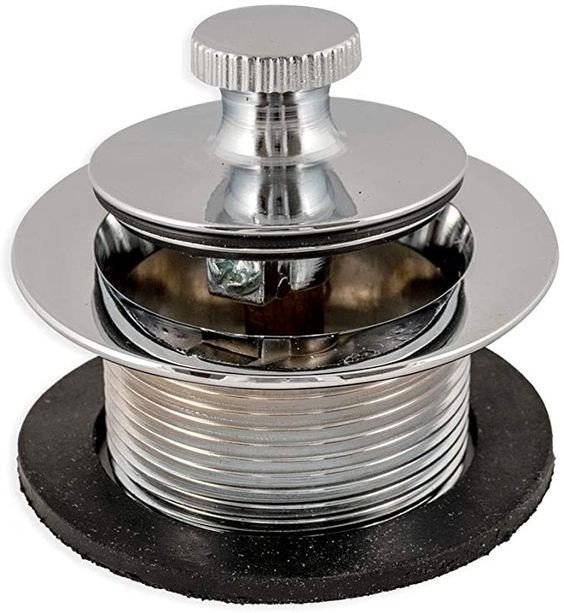
This drain stopper is a cost-effective drain option that works well for most bathtub types and materials.
It features a small knob that a person needs to twist to open and close the stopper. The lift-and-turn is designed to be easy to install and can pair well with most designs and shapes.
The main flaw of the stopper, however, is that it is challenging to remove if over-tightened.
2. Toe-Touch
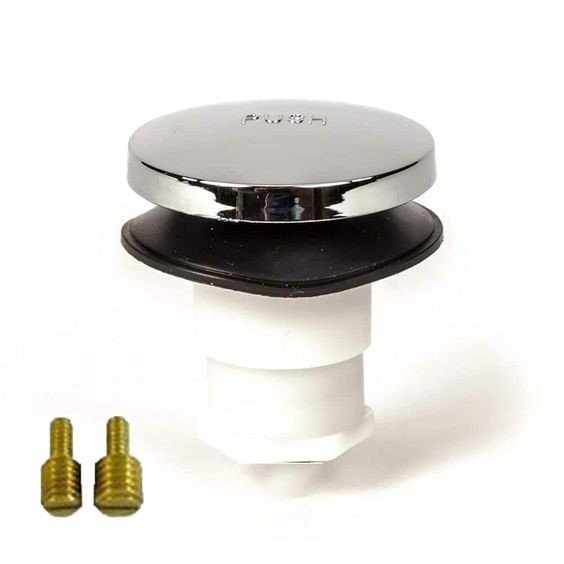
The toe-touch drain stopper is the easiest to use out of all the options. As the name implies, it has a spring-loaded design that opens and closes the tub drain with a simple push and nudge of the toe.
Unfortunately, the spring mechanism of the stopper will eventually wear down and out based on use.
3. Push-and-Pull
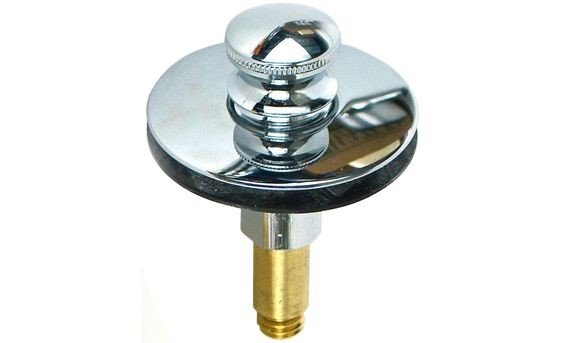
Almost similar appearance-wise to lift-and-turn drain stoppers, the push-and-pull is an inexpensive option that works by pulling up to open and pushing down to close. It is relatively easy to install, requiring only the use of a set screw.
Thanks to the minimal practical design of the drain stopper, the push-and-pull rarely requires repair. Though, it does wear over time.
4. Trip-Lever
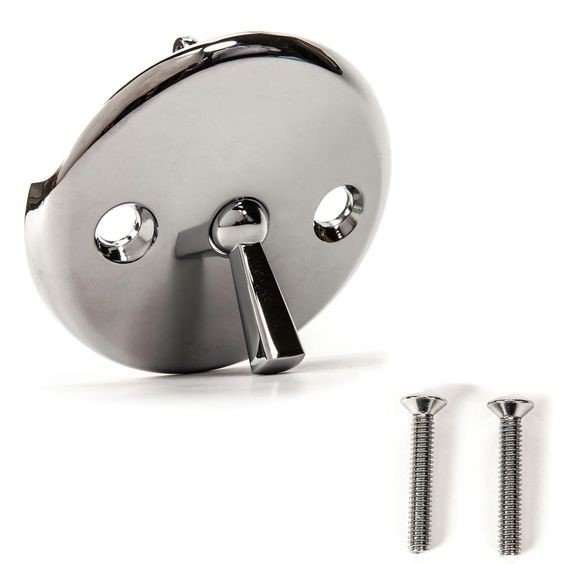
The trip-lever drain stopper does not have a visible stopper — instead, it has a strainer. This type uses a plunger in its overflow pipe, which moves to open and close the drainpipe.
It is relatively cheap, although installing and maintaining the stopper can get complicated.
5. Pop-Up

This drainer looks quite similar to a bathroom sink drain. It operates using the same lever as the trip-lever stopper. By moving the drain lever, the connecting rod linked to the overflow drain pipe will pivot the rocker arm connecting the pop-up stopper.
It sounds complicated — which it technically is. It has a complex design that makes it likely to collect debris and hair.
6. Flip-It
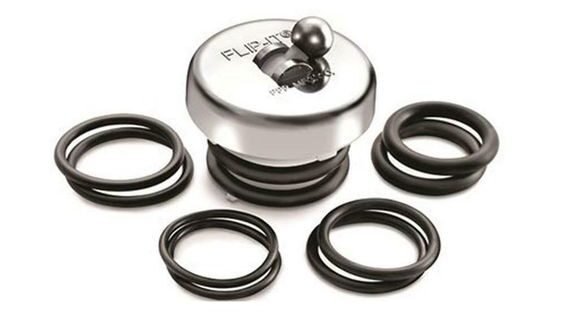
The flip-it stopper features a toggle lever on top that can move from side to side to close and open the drain. The drain has O-rings underneath, which move with the toggle to release or close the watertight seal.
It is relatively low maintenance, but the O-rings will wear over time after frequent use.
| Pros | Cons | |
| Lift-and-Turn | Affordable and durable | Tricky to remove |
| Toe-Touch | Easy to use and reach | Springs wear out |
| Push-and-Pull | Affordable and durable | Tricky to remove |
| Trip-Lever | It does not require reaching down to adjust | Maintenance and installation are complicated |
| Pop-Up | It does not require reaching down to adjust | Maintenance and installation are complicated |
| Flip-It | Easy to install | O-rings will wear out |
Maintaining And Caring For Bathtub Drains
Homeowners must learn how to maintain and clean a bathtub drain to use it efficiently. Adding to that, they must also know how to address any issues that might arise.
To help, we compiled some tips on cleaning and fixing bathtub drains!
Cleaning And Maintaining A Bathtub Drain
A dirty drain can leave horrible odors and clogs in the bathtub. For that reason, the owner should make an effort to maintain and clean it. See below a few valuable tips to get started:
- Pour boiling water down the tub drain to dissolve debris, hair, and soap scum lurking within it.
- Pour baking soda down the drain and let that sit for at least 20 minutes.
- Remove the gunk deep within the drain with a bottle brush.
- Avoid pouring oil, grease, or large amounts of hair down the drain since those can cause clogging.
- Upon noticing leaks in the drain assembly, address them promptly to avoid water damage and other issues.
Fixing a Clogged Bathtub Drain
A clog in the bathtub drain can be a messy ordeal to worry about. Sitting idly by and waiting for it to unclog by itself won’t fix the problem. In fact, immediate action is required.
Here are a few methods that can help unclog the bath and shower tub drain:
- Baking Soda and Vinegar: The classic method is pouring half a cup of baking soda on the drain and following it with vinegar. Let that sit overnight before pouring hot water on it the morning after.
- Plunger: Pour hot water into the tub and let it reach about one or two inches, enough to cover the edges of the plunger. Place the plunger against the drain and plunge up and down to force water in and out of the pipe.
- Drain Snake: A drain snake can latch on the pesky clogs and pull them up through the drain.
- Expert Plumber: If the clog persists despite doing the methods above, call in a professional plumber to deal with it.
Summary
Understanding how a bathtub drain works can help homeowners appreciate the intricate mechanisms that make it an essential piece of equipment. It works like any other standard drain — removing the stopper means creating an opening to let the water through while placing back the stopper means plugging it to keep the water from draining.
Learning about the basics of a bathtub drain is not enough. People must also learn the proper care and maintenance of bathtub drains to ensure pleasant baths in the future!








